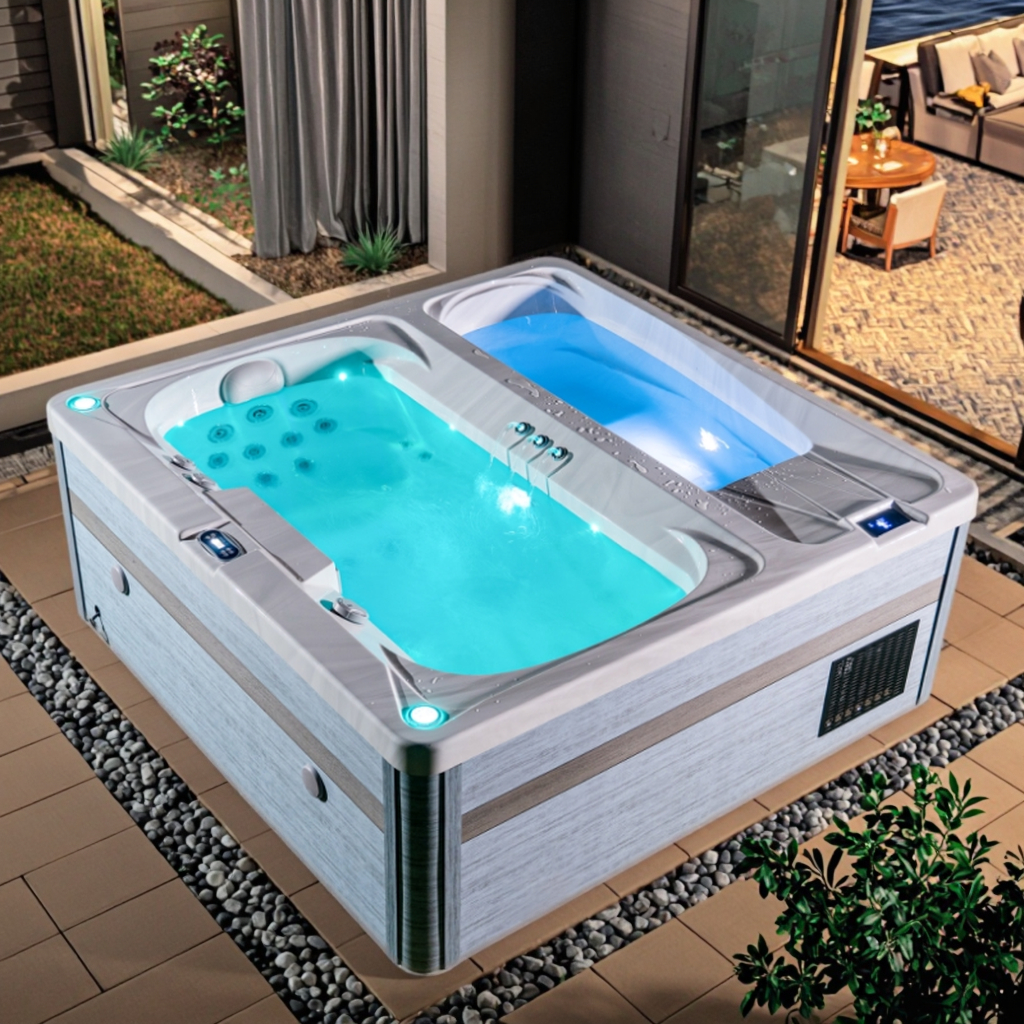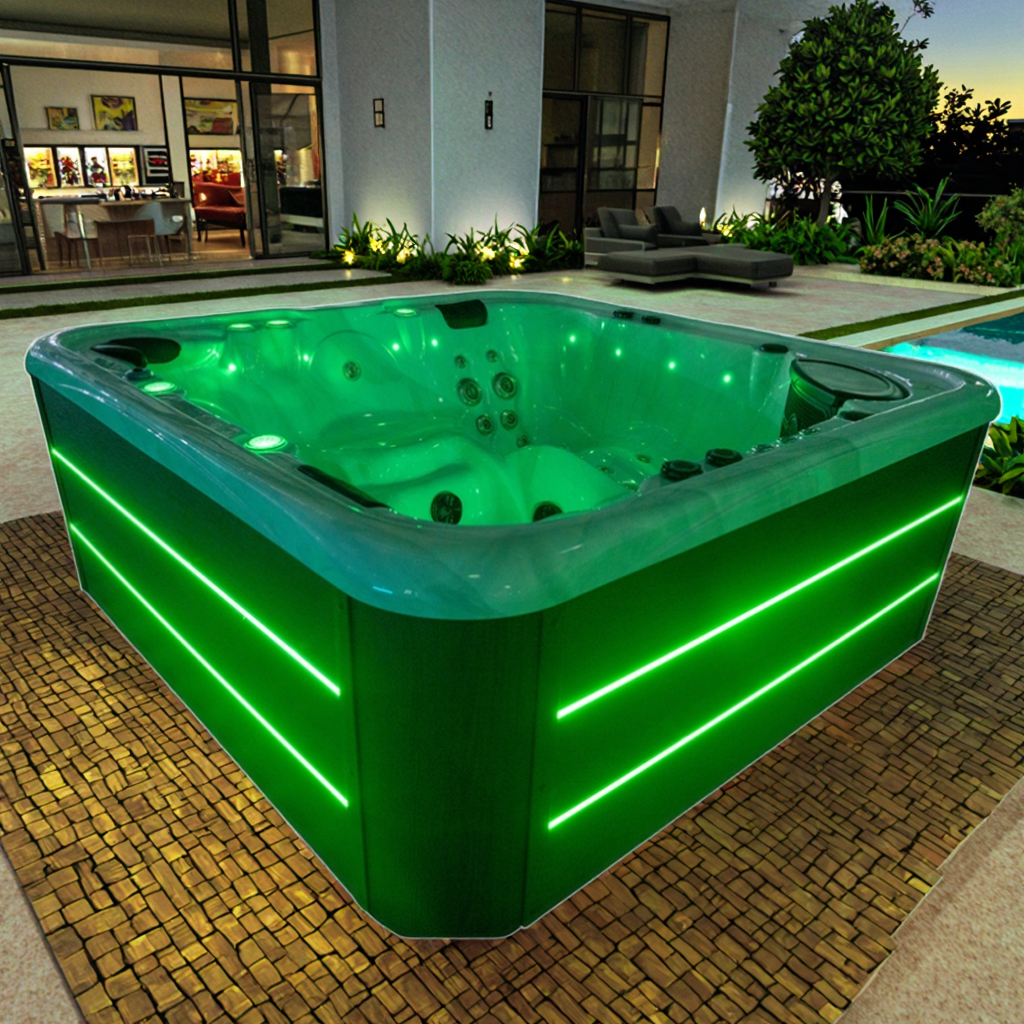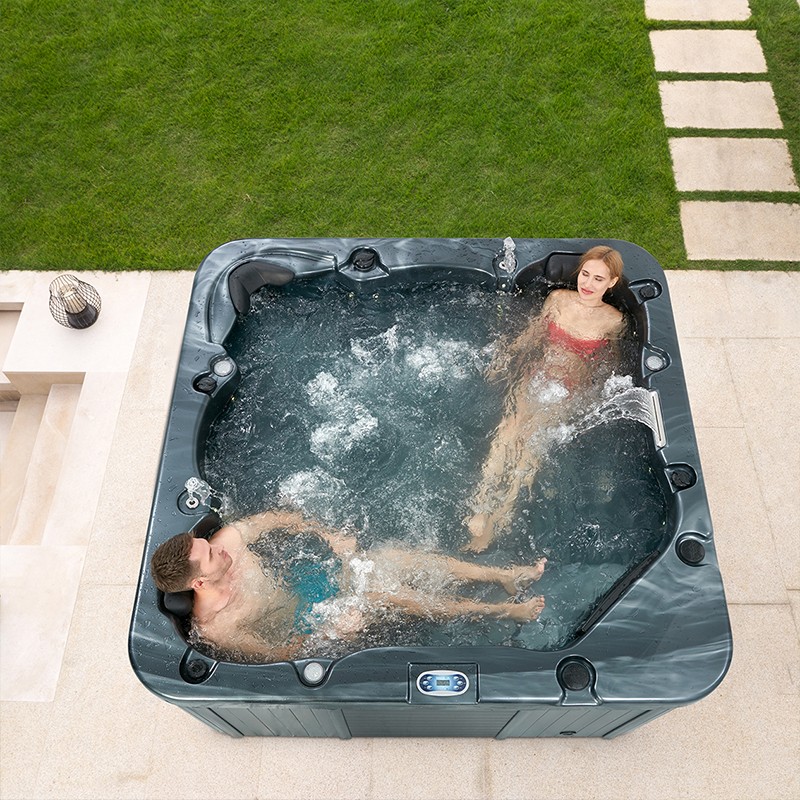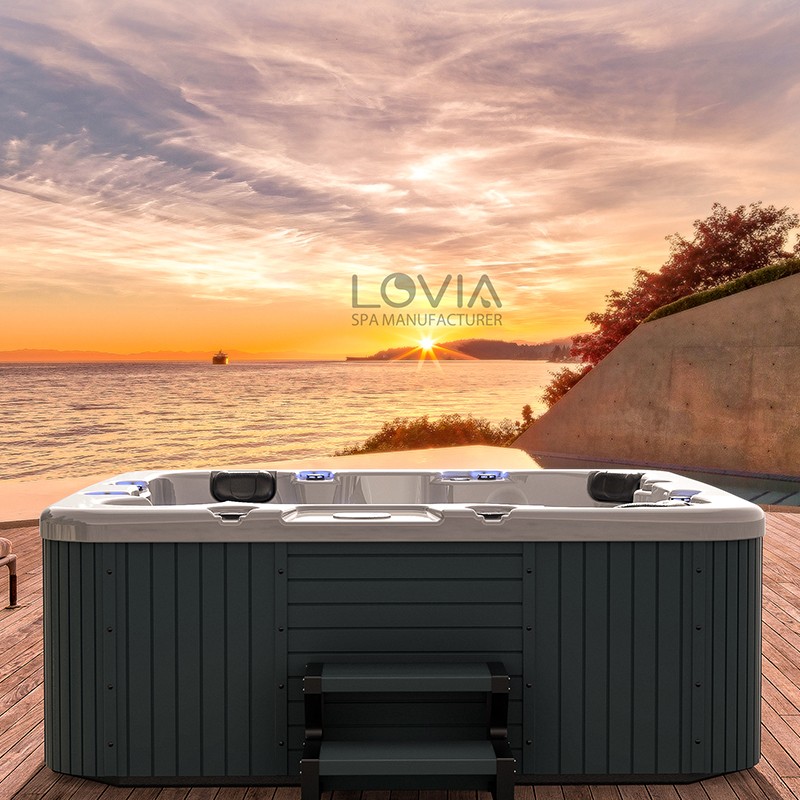
Why does the water in an outdoor spa hot tub turn green?
2025-11-18 15:35Many users encounter this problem when using an outdoor spa hot tub: the water, which was originally clear and bright, suddenly turns green after a few days.
This raises concerns about water quality deterioration, bacterial growth, and even whether the equipment is malfunctioning.
In fact, green water in an outdoor spa hot tub is not uncommon. It is usually related to factors such as water chemical balance, disinfectant concentration, metal ion precipitation, and algae growth.
This article will analyze the true causes of green water from a scientific perspective and provide feasible solutions and prevention measures to help you keep your outdoor spa hot tub crystal clear for a long time.

Why does the water in an outdoor spa hot tub turn green?
There are two main categories of reasons why outdoor spa hot tub water turns green:
One is discoloration caused by chemical reactions; the other is greening caused by biological pollution.
Identifying which situation is causing the problem is the first step.
1. Greening caused by chemical reactions
This situation is often related to metal elements.
When water contains high concentrations of metal ions such as copper, iron, and manganese, an oxidation reaction occurs when it encounters chlorine or bromine-based disinfectants, turning the water pale green or bluish-green.
Common causes include:
• Using well water or hard water in the bathtub;
• Metal corrosion in pipes causing ion leaching;
• Excessive use of chlorine disinfectants.
This green water may appear clean, but it is actually suspended metal oxides, not algae.
2. Green Water Caused by Algae Growth
If an outdoor spa hot tub is exposed to sunlight for extended periods, if disinfectant is insufficient, or if the filtration system is not functioning properly, algae will grow and multiply rapidly, causing the water to appear noticeably green or cloudy.
Algae not only affect aesthetics but also disrupt the water balance, weaken disinfection effectiveness, and allow bacteria to thrive.
This is one of the most common causes of "green water."

Why are outdoor spa hot tubs prone to algae growth?
Many people mistakenly believe that "hot water" can inhibit algae growth, but in reality, the temperature of an outdoor spa hot tub (30-40℃) is insufficient to kill algae spores. Conversely, the following factors can actually promote algae growth:
1. Sunlight Promotes Algae Reproduction
Outdoor spa hot tubs are typically placed in patios, patios, or gardens, receiving prolonged exposure to sunlight.
Algae grow through photosynthesis, and the stronger and longer the sunlight, the faster they multiply.
Especially in summer or in areas without shade, algae numbers can increase exponentially after just a few hours of direct sunlight.
2. Inadequate Water Circulation
If the filtration and circulation time is insufficient, the water flow will be too slow, leading to stagnant water in dead zones.
Still, warm water is ideal for algae attachment and growth, especially around pipes and nozzle edges.
3. Decreased Disinfectant Concentration
High temperatures accelerate the volatilization of chlorine or bromine, while ultraviolet rays in sunlight also break down chlorine molecules.
Once the effective disinfectant concentration in the outdoor spa hot tub falls below 0.5 ppm, algae can multiply rapidly.
4. pH Imbalance
When the pH is above 8.0, the bactericidal effect of chlorine will decrease to below 30%.
Therefore, even with sufficient chlorine, the water may still lose its algae-suppressing effect, turning green.

How does chemical imbalance in water quality cause outdoor spa hot tubs to turn green?
Besides algae, chemical factors are also a significant cause of green water.
Here are three typical cases of chemical imbalance in outdoor spa hot tub water:
1. Copper Ion Oxidation Reaction
Tap water in many areas contains small amounts of copper ions. When these ions encounter chlorine or bromine, they are oxidized into green copper salts (such as copper oxide), giving the water a bright green color.
If the copper concentration is high, it may also form light green stains on the tank walls.
2. Iron or Manganese Ion Precipitation
Metals such as iron and manganese are easily oxidized into colored precipitates under high temperatures, causing the water to turn yellow or green.
This is more common in well water or groundwater sources, especially during the initial filling.
3. Excessive Chemical Reaction
Sometimes, users add too much chlorine tablets or disinfectant at once for quick cleaning, causing an overly strong oxidation reaction that combines with minerals in the water to form colored compounds.
The result is—the water turns green, but this is not actually due to dirt; it's a sign of chemical imbalance.
How to determine if green water in an outdoor spa hot tub is caused by algae or a metal reaction?
The root cause of the greening can be quickly distinguished using the following methods:
Testing methods | If it is algae | If it is metal oxidation |
| Observe color | It will be yellowish-green and cloudy | It will be blue-green and clear |
| Touch tank wall | It will feel slippery | It will not feel slippery |
| Add chlorine test | It will become cloudy or bleached after chlorination | The color will deepen or turn bluer |
| Water quality test strips | Residual chlorine will be low, and the pH will be high | The metal ion reading will be high |
These basic judgments will help identify the type of "greening" and allow for appropriate treatment.
What to do if the water in an outdoor spa hot tub turns green?
Whether it's algae or a chemical problem, the key is to take immediate action; otherwise, the situation will worsen within 24 hours.
The following are the steps to address different causes.
1. Treatment for Algae Problems
1). Adjusting Water Balance:
First, use test strips to check the pH value and adjust it to between 7.2 and 7.6.
2). Intensive Chlorine Shock Treatment:
Add chlorine shock agent according to the recommended ratio (10g per 1000L of water), maintain circulation for at least 2 hours to thoroughly kill algae spores.
3). Scrub the Tank Walls and Filter:
Algae often adheres to nozzles, pipe walls, and filter cartridges, requiring manual cleaning.
4). Replace Part or All of the Water:
If algae infestation is severe, drain half the water and refill with clean water to dilute the contamination concentration.
2. Treatment Methods for Metal Reactions
1). Add Metal Sequestrant:
This chemical binds to copper and iron ions, rendering them non-reactive and preventing further discoloration.
2). Use Soft or Filtered Water for Top-Up:
Avoid using well water directly; if local tap water has high hardness, use a household filtration system.
3). Clean the Tank Walls and Replace the Filter Cartridge:
Remove deposited metal oxides to prevent their re-release into the water.
4). Check for rust in the pipes:
Metal parts of older equipment may corrode and should be replaced or maintained regularly.

How to prevent outdoor spa hot tub water from turning green?
Prevention is better than cure. Good daily maintenance can keep your outdoor spa hot tub clear and colorless for a long time.
1. Maintain stable water quality
• Keep pH between 7.2 and 7.6;
• Maintain total alkalinity between 80 and 120 ppm;
• Regularly test chlorine or bromine concentrations (1-3 ppm).
Stable water quality prevents chemical imbalances and algae growth.
2. Use algaecide
Adding a small amount of algaecide weekly can effectively inhibit spore germination.
This is especially important in sunny outdoor environments.
3. Regularly circulate the filter
It is recommended to turn on the filter system at least twice a day, running it for at least 2 hours each time.
A continuous water flow prevents water accumulation in dead spots and ensures even distribution of the oxidant.
4. Use Dust Covers and Sunshades
After use, cover the tub with a dust cover or install a sunshade. This prevents impurities from entering and reduces direct sunlight, effectively inhibiting algae growth.
5. Choose High-Quality Disinfectants and Chelating Agents
Cheap or inferior chemicals can easily leave residues and reaction byproducts.
Choosing high-purity professional products can significantly reduce the risk of water discoloration.
6. Regularly Change Part of the Water
It is recommended to change 1/3 of the water every 2-3 months to maintain chemical balance and cleanliness.
Why Should Green Water in Outdoor Spa Hot Tubs Be Discontinued?
Many people believe that as long as the water doesn't look too dirty, they can continue to use it, but this is very dangerous.
When outdoor spa hot tub water turns green, it often means that the water quality has been compromised:
• The disinfectant has become ineffective and cannot inhibit bacteria;
• The pH level is too high, which may irritate the skin;
• Microorganisms have accumulated in the pipes and nozzles;
• Metal deposits may corrode the equipment.
Continued use not only affects the user experience but may also cause skin itching, eye irritation, or equipment malfunction.
Therefore, if the water turns green, stop using it immediately, clean it, and then refill it.
How should the maintenance frequency of an outdoor spa hot tub be scheduled?
A scientific maintenance plan can effectively prevent the water from turning green. The following is a recommended maintenance schedule:
Project | Frequency | Objectives |
| pH and chlorine concentration testing | Every 2 days | Maintain disinfection effectiveness |
| Filter cleaning | Weekly | Remove impurities and algae |
| Tank interior wall wiping | Weekly | Prevent biofilm formation |
| Adding algae inhibitor | Weekly | Inhibit algae growth |
| Shock disinfection | Monthly | Thoroughly sterilize and remove algae |
Filter cartridge replacement | Every 3 months | Ensure filtration efficiency |
| Partial water replacement | Every 2-3 months | Maintain water quality balance |
Adhering to this maintenance plan will ensure that the outdoor spa hot tub remains clear and green.
Will green water in an outdoor spa hot tub damage the equipment?
Yes, if ignored for a long time, green water not only affects the visual appeal but may also damage the equipment.
• Algae clog nozzles and filters, causing poor water flow;
• Metal oxide deposits corrode the pump and heater;
• pH imbalance shortens the lifespan of seals and pipes.
Therefore, while green water may seem like a mere aesthetic issue, it actually affects the lifespan and safety of the outdoor spa hot tub.
How Can I Get a Discount or Promotion from LOVIA SPA?
We regularly offer promotions, seasonal discounts, and volume-based deals for wholesale and retail buyers. Contact our sales team to check current campaigns or request a quote for your purchasing plan. LOVIA SPA provides low factory prices all year round and extra discounts for bulk or repeat customers. Our goal is to make every buying experience cost-effective without compromising quality.
Don’t miss our upcoming sales events — buy direct from the LOVIA SPA factory and enjoy premium spas at unbeatable prices.
